Dodge got handed a bag of lemons – with lots of brown spots – in the form of government regulations that have effectively outlawed the kinds of cars that only Dodge offered, that sold really well for just that reason. Because they were passionate cars – which is why people wanted to buy them.
They were the Charger and Challenger, soon-to-be past tense.
Cars that didn’t make apologies for the big V8s – and the big personalities – they offered. They reveled in them. And so did those who bought them. But such cars are reviled by the people who run the government, who are using it to push such cars off the market (using regulations such cars cannot comply with) in order to make room for the kinds of cars the government wants people to drive.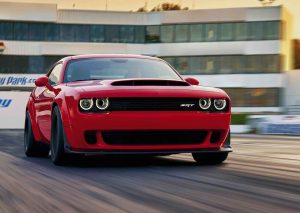
That being cars with very little under the hood – and not much personality.
Where does this leave Dodge?
Trying to make some lemon aide.
What It Is
The Hornet is a compact-sized crossover (sigh) that Dodge has tried hard to infuse with some personality, in order to differentiate it from all of the other compact-sized crossover SUVs literally everyone else is trying to sell.
The main sell here is what Dodge has spent the past 15-plus years selling – that being performance. It does not come from a V8, however.
The standard engine in the $29,995 GT is a turbocharged four cylinder engine that boasts 268 horsepower, paired with a standard all-wheel-drive system. It is the strongest small crossover you can get for the price – the latter (i.e., value) being the other thing Dodge sells.
You can order more performance, too – in the form of the R/T (this nomenclature has up to now been reserved for V8-powered versions of Dodge performance cars like Challenger and Charger) which is a performance-oriented plug-in hybrid. It also has a turbocharged four cylinder engine but augmented by a plug-in hybrid system that amps up the output to 288 horsepower and reduces the fuel consumption by enabling this version of the Hornet to power itself using electricity part of the time.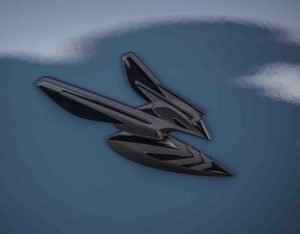
It lists for $39,995.
A top-of-the-line R/T Plus (which gets additional features and amenities) lists for $44,995.
What’s New for 2023
The Hornet is a new addition to the Dodge lineup and represents the new direction Dodge is being forced (effectively) to take.
What’s Good
Less boring to drive than most small crossovers.
Costs less to start than a V8 Charger or Challenger.
More practical than a V8 Charger or Challenger
What’s Not So Good
It’s (sigh) another small crossover.
Not as practical as other small crossovers in the class.
It’s not a Charger or a Challenger.
There’s not much more engine – in terms of size – under the hood of the Hornet vs. other crossovers.
But there is a lot more standard power. – vs. what’s under the hood of most other small crossovers.
The GT’s standard 2.0 liter turbocharged four – paired with a standard nine speed automatic – is the same size as a multitude of other 2.0 liter fours powering what seems to be almost everything – not just small crossovers, either. Two-point-0 fours power mid-sized luxury sedans such as the current BMW 5 and the Mercedes E-Class.
But its output is a cut above the rest.
The standard version in the GT makes 268 horsepower – substantially more than 184 horsepower emanating from the VW Tiguan’s 2.0 liter four and also the BMW X1’s 241 horsepower 2.0 four. There’s no supercharger whine – that’s now a memory of better times – but there is a lot of boost. About 22 psi at full tilt and – if you dial up the Performance Pages app on the LCD touchscreen – you can watch the boost ebb and flow as you drive.
Floor it and the Hornet GT can get to 60 in a little over six seconds, which is very quick for the class. As a counterpoint, the Subaru Crosstrek I reviewed last week needs about nine seconds to get to 60 with its standard 2.0 liter engine – there you go, again! – and even with its optional 2.5 liter engine, it’s still a solid 2 seconds behind the Dodge.
The plug-in hybrid version with 288 horsepower that ought to be available later this fall or by early 2024 ought to be a little quicker and (according to preliminary reports) will be capable of going about 30 miles entirely on battery power – which can be recharged by plugging in rather than gassing up (in a conventional hybrid, the running engine recharges the battery). No data is yet available as far as the gas mileage this version of the Hornet – the R/T – will be but it ought to be significantly higher than the non-hybrid GT’s 24 city, 29 highway.
Which is the price you pay for being able to get to 60 in a little over six seconds.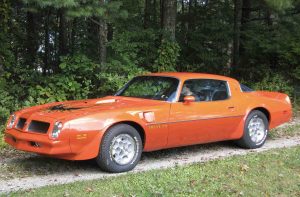
One of the rather shocking stats about this little Dodge is how much it weighs – which is 3,750 lbs. for the GT. That is almost exactly as heavy as this writer’s 1976 Pontiac Trans-Am, which is a V8-powered muscle car that was considered heavy in its day. But given that it is a V8-powered muscle car (and a much larger car; it is nearly two feet longer) it is a lightweight car relative to this Hornet.
The latter ought to weigh far less than it does, because it isn’t a V8 muscle car – and it doesn’t have a cast iron engine or a truck-like bolt-on steel girder front subframe like my old Pontiac does. Much of the Dodge’s exterior is draped in plastic and very thin-gauge metal, too.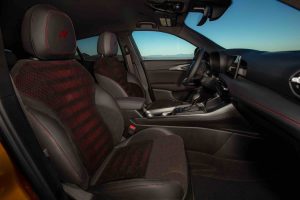
And yet it is almost a two-tonner as it sits – before anyone sits down.
Government regs – having to comply with them, that is – certainly play a role in this heaviness, but they do not explain all of it. The Crosstrek – which is only slightly smaller than the Hornet (by about two inches overall) has to comply with the same federal ukase but it manages to weigh-in at 3,117 lbs. A Honda CR-V (which is larger than the Dodge) weighs 3,472 lbs.
So, the Hornet is a heavy hitter, like the dearly departing Challenger and Charger (the latter only weighs 3,947 lbs. by the way) that makes up for its bulk with power. But if the Hornet weighed 300 pounds less – or about as much as a Honda CR-V – how much more powerful would it feel?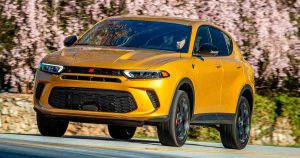
On The Road
How to make another crossover drive differently than all the other crossovers? More finely, how to make a crossover that will appeal – to the extent feasible – to people who will soon no longer be able to buy the Charger or Challenger they’d probably rather have?
Well, you try to make a crossover that’s less like all the others.
It’s not an easy job, given the parameters. Kind of like trying to make alcohol-free beer appealing. Not that there’s anything wrong with crossovers – as such. Obviously, many people like them. But there are also many of them already available.
Anyhow, Dodge tries to make the Hornet different by making it more powerful, which gives it a more forceful feel when you floor it. This will appeal to people who like crossovers for their practicality but miss having more than a passing ability to pass anything. The Soobie Crosstrek reviewed here last week, for instance, is to passing what Joe Biden is to cognition.
Both take awhile.
The Hornet doesn’t. You can flex your Go muscle here, whenever the need arises. It does not go like a V8 Charger or Challenger – but then, what does? The point is it goes better than vehicles of its type and that is what Dodge is hoping will keep people who bought Chargers and Challengers from buying some other brand’s crossover.
The Hornet is more agile than the usual in this class, probably because it is based on the also-new Alfa Romeo Tonale (Alfa is part of the Stellantis family, which encompasses Dodge, Chrysler, Ram and Jeep). Which – being an Alfa – was designed to be something more than just another small crossover.
Regardless, both versions of the same basic thing share the same basic suspension and steering tuning as well as an available upgraded Brembo brake package that includes red powder-coated front calipers (another echo of Challenger/Charger R/Ts past).
The result is a more responsive crossover and – maybe – that will be enough to counter the fact that it’s still another crossover . . . and isn’t a Charger or a Challenger. When you’re used to steak, getting a bologna sandwich doesn’t quite hit the spot.
There is one area, though, where the Hornet is a lot like the forced-off-the-market Challenger and Charger.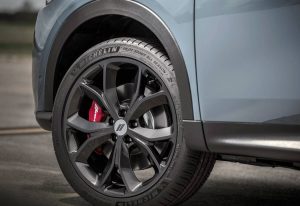
It is a thirsty thing.
The advertised 20 city is only 1 MPG better than the V6-powered Charger’s 19 city rating – and only 4 MPG higher than the V8-powered Charger R/T’s 16 MPG, city. In real-world driving, there is almost no difference at all – because to get the Hornet to Go, you’ll be on boost most of the time. Even if you drive it hyper-mile style, like a Prius, it’ll still use not much less gas than a V8 powered Charger or Challenger.
Without being a Charger or Challenger.
But – here’s the trick. Or rather, the scam.
On paper, the Hornet “emits” less gas. That is to say, less carbon dioxide – the inert, non-reactive gas that plays no role (as in zero) in causing or worsening air pollution. But it is advertised as a “pollutant” – and more to the point, regulated as such. A V8 – being a large-displacement engine – processes a lot of air. It therefore “emits” a lot of C02, though almost no actual pollution. A small turbocharged four “emits” less C02 because it inhales less – and so exhales less.
Except when it is under boost.
Then it exhales a great deal more. But it gets credit for “emitting” less when it is not under boost, so everyone can pretend its “emissions” are less. Of course, less is never enough for the zealots who are pushing for zero – which is why the Tonale has an even smaller (1.3 liter) engine and will have none at all (according to Alfa) by 2025.
Expect the same here, by then.
At which point, the Hornet will be just another crossover. Or rather, just another battery powered appliance.
At The Curb
There are remembrances of the Challenger and Charger when the Hornet is viewed from head-on (and in the attitude that Dodge tries to resuscitate via the stylized Hornet “stinger” badges on the front fenders). But – sigh – viewed from the side – it looks a lot like other crossovers.
Not – again – that there’s anything wrong with that. Per se. If there weren’t already so many others out there (including the Tonale) the Hornet would look like something different. That was how the original Lexus RX300 looked when it appeared back in 1998. Now that look is a lot like the tattoos one sees on just about everyone’s calves and forearms.
But it does have the same – or similar – virtues as others of its kind. The chief one being how much room there is inside in spite of its small size, outside. It is only 178 inches long – vs. 198.4 for a Charger sedan. That is a difference in length of nearly two feet. But the much-longer Charger only has 16.5 cubic feet of space in its trunk – vs. 22.9 cubic feet behind the Hornet’s back seats. Fold those down and you open up 50.5 total cubic feet of cargo-carrying capacity.
The Hornet has that going for it.
The problem – insofar as Dodge selling the Hornet – is that so do all the others. While the Charger and Challenger were less practical, there was nothing else like them. If you wanted something like that, you bought a Dodge – because no one else had anything like them.
Dodge tries (again) to make the case that this is something unlike what everyone else is selling, by echoing things like the Performance Pages app you can use to toggle through various displays that include a readout of torque (but not horsepower) the engine is making in real-time, as you drive. Plus boost – and so on.
More echoes are apparently forthcoming in the form of a Tech Pack (echoing Track Pack) for the pending plug-in hybrid version that focuses on electronic “assistance” such as an “enhanced” version of the standard adaptive cruise control system (which operates like a semi-self-driving feature that can semi-steer the car as well as maintain and adjust speed in relation to the flow of traffic).
And there will be a Track Pack – that includes some performance-upgrade hardware such as a 20-inch wheel/tire package and an adaptive suspension with driver-selectable settings.
But the sound of the echoes – of the past – that linger in one’s mind are harsh reminders of the present.
The Rest
It is likely you will be able to haggle yourself a deal on a new Hornet – if you’re interested – precisely because Dodge will need to deal to get people interested. There is a lot of competition out there already – as there never was for the Charger and Challenger.
To persuade you, Dodge dealers are going to have sell you.
It’ll be interesting to see whether they can.
The Bottom Line
This new Hornet is a prequel of Dodge’s New Direction.
Do you like what you see?
. . .
If you like what you’ve found here please consider supporting EPautos.
We depend on you to keep the wheels turning!
Our donate button is here.
If you prefer not to use PayPal, our mailing address is:
EPautos
721 Hummingbird Lane SE
Copper Hill, VA 24079
PS: Get an EPautos magnet or sticker or coaster in return for a $20 or more one-time donation or a $10 or more monthly recurring donation. (Please be sure to tell us you want a magnet or sticker or coaster – and also, provide an address, so we know where to mail the thing!)
If you like items like the Keeeeeeeeev! t shirt pictured below, you can find that and more at the EPautos store!



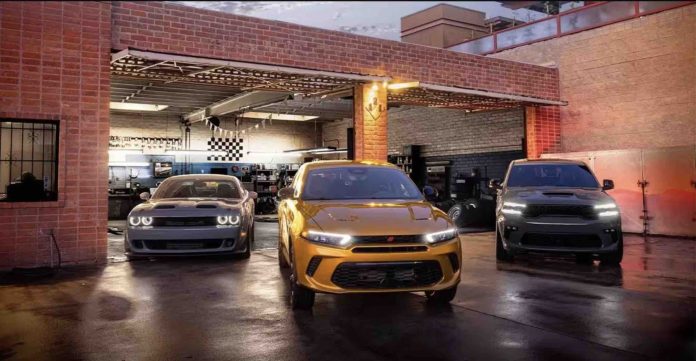



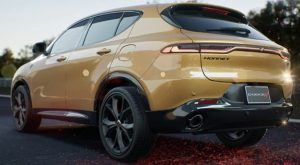







They’re discontinuing the Charger and the Challenger for this effing rubbish? Earth is truly the sh**hole planet of the galaxy.
Hi Krazy,
Yup. It’s tragic, isn’t it? And we’re supposed to just pretend it’s all a normal “transition.”
I was proud of dodge for initially giving the finger to the Global Gretas.
Now, just sad.
2.0L crossovers are uninspiring. Can’t get excited over them.
It’s worse when you consider what used to be & what could have been.
That’s not a good car.
Regarding the Challenger and Charger, aren’t they going to keep them around and just batteryize them and then add fake motor sounds as you press the (not) gas pedal?
One other thing from the article, the assisted driving that will drive the car for you (sort of) isn’t that dangerous as hell? When I get sleepy behind the wheel, knowing I have to stay awake is a big motivating force to not falling asleep. What happens when your sleepy mind thinks the car can drive itself?
Hi Easy,
The Challenger is cancelled. An electric Charger is apparently coming. It’s The End for Dodge, in my estimation. Dodge was different. When all Dodge sells is EVs, it will be the same – and why bother? How many different shapes and colors of the same can the market support?
The vehicle may be fine. But ‘Hornet”? They’ve gotta he shitting us. I realize they bought all of AMC’s trademarks back in ’87, but trust me, no one pines over a ’73 AMC Hornet. OTOH, what better ride for 007 to execute a “corkscrew flip” in?
https://youtu.be/NaqXxC0rhSw?si=C0zIYzGqSyjdx_SB
I sure AM, boy!
Golden Gun was the best Roger Moore Bond film. A dadgummed flyin’ Matador.
Dodge dealers have hard job coming up. At best the hornet is a overpriced also ran. No current charger or challenger owner is going to want the battery powered one. The electric fanboys won’t buy Chrysler.
That’s the thing about smaller vehicles. They have big price tags. So people go, why bother, just for a few bucks more a month I can “get” a larger size. Small cars if they had small price tags like they used to, would sell.
I agree, Rich –
Part of me wants the thing to do ok so that Dodge does ok; but the other part of me says: If only Dodge had openly defied these SOBs and just kept making the Charger and Challenger (and Durango) then this “transition” wouldn’t even be happening.
I couldn’t care less anymore. It’s done. We are officially worse off than most third world nations now. In fact, they are where you can find IC powered cars.
I remember reading somewhere that the US autobuyer gets the junk from europe and japan. They get the good stuff. The junk is the prepacked generic overly optioned crap that came from Mercedes, Toyota, and BMW, etc.
If you go to Germany, Japan, or even eastern Europe, you get much better automotive choice than here. Brands most never heard of… Scania, Skoda, Daihatsu, the list goes on. Our market is full of cars that draw the maximum out of the American car buyers pocket.
Even our domestic brands had better cars overseas until recently. Holden, for instance, wasn’t just from Australia. they sold inthe Middle East. Ford sold the Falcon in other countries. Not here.
Our industry was a shell of itself in the 70s and 80’s compared with the 60’s, nevermind today….
The US automotive industry disgusts me. They don’t stand up to anything. In Germany, they had teh ADAC for a long time. They actually stood up for motorists at some point. They made sure, until recently, that car makers and customer’s interests were heard by the regulatory apparat. Not here. The woke morons that began cropping up in industry in the early to mid 1970’s spread throughout companies like the metatastic cancer they are. Now the host is dead.
Early indicators of the rot taking place in the US industry:
1. Automakers reduced the speeds on the speedometers from 120 to 100 mph for most of the 1975 model year vehicles because of the 55 mph speed limit and the “speeeeeeed kiiiiiiilllls” mantra
2. In 1984, Chrysler Corporation started installing Airbags in cars and advertising “saaaaaaaaafety”
3. In 1990, no protesting the Clean Air Act. No industry opposition whatsover. No advertorials. Just comply….
4. No help from them whatsoever on getting the repeal of the 55 mph speed limit. In fact, GM and Ford were somewhat vocal advocates of keeping their customers chained to the unreasonable limit.
5. No opposition to the following. TPMS Sensors that came in teh wake of Fords stupidity with the Explorer and Firestone Tires. Cumbersome rollover and side impact regulations that were beginning in the 2000’s. Corporate avarage fuel economy regulations in the Energy Conservation Act of 2007.
The auto industry has dug its own grave. They are assholes.
I don’t want to see them die, but they certainly have deserved their fate. It is us that has to deal with it. Along with the millions that will eventually lose their jobs.
They stopped fighting when they lost the airbag mandate battle. It was the last thing they put up any real fight against. We’ll never be sure why but my guess a big part of it was that is when they realized the federal government was willing to kill people to get its way. The unbelted average male standard is deadly and automakers had to have known it. They stopped offering airbags in the 1970s and my guess is that beyond low take rates and expense, they found that problem. An airbag that stops a man from hitting the windshield kills a child. Then after the mandate small women and children being killed by airbags and the government response to it, to keep that standard (with rube goldberg nonsense we still live with), I think it demoralized people.
Hi Brent,
Years ago I read that GovCo prevented auto manufacturers from informing their customers about the real risks of airbags. It could be a false memory, as I cannot find the article. Anyway, if anyone remembers reading about that, and has a link, that would be great.
Cheers,
Jeremy
Now that you mention it, that sounds vaguely familiar. I think that was something the automakers pushed for when they lost the battle and they lost on that too. Until govt started requiring big ugly warning labels. First hidden on the back side of the visors in the mid-late 1990s and now on the front side. On my newest car I removed them because I hated looking at them.
It might have been from Liberty magazine, edited by RW Bradford. Their site is long inactive and the search feature doesn’t work. Oh well. Pretty sure I read a good article on the topic. Gist was that the car manufacturers informed GovCo that air bags would kill small people but the safety apparatchiks were willing to sacrifice the “few for the many” and didn’t want any public resistance at the time.
Hi Brent,
You’re right – and I know, because as it happens, I was there to see it. In the early-mid ’90s, when the air bag thing was really getting rolling, the people I knew at GM and Ford and Chrysler were pushing back against it, openly and otherwise. The whole culture has changed since then. They are now all-in (aggressively so) as regards “safety,” which has come to mean more idiot-proofing, regardless of the cost and no matter how silly or obnoxious.
I am grateful that I’m not 25 and just starting my career as a car journalist as there’s not much future in it.
When I hear Hornet…I think of AMC…….and better times.
I think of replacing my ’71 Hornet’s transmission with one off a junked Ambassador for $75. All three AMC V8s were essentially the same on the outside. Unfortunately I was a poor high school student back then and couldn’t buy the accompanying 401 V8 for $100 more.
Being that this a Fix It Again Tony, it will be expensive to fix when it breaks. Italian cars aren’t known for their Toyota-like reliability.
And it’s boring. Another 2.0 liter 4-banger huffing too much boost. The internals of that little motor are a ticking time bomb, especially if you have a heavy foot. But hey, it doesn’t spew a lot of CO2, so regulators are good with it being a turd.
Dodge is dead, but so will all the other automakers when the EV “transition” hits fully. There isn’t a dime’s worth of difference between a crossover from Brand A or Brand B, just like interior treatments, styling, range and power separate the EVs from one another. Uncle Sam has completely destroyed the domestic auto industry as other governments worldwide. My heart breaks for all of the people that work in the auto industry and its sales arm who won’t have jobs in the WEF-enforced future.
“My heart breaks for all of the people that work in the auto industry and its sales arm who won’t have jobs in the WEF-enforced future.”
Yep! From what I see of 21st century men I suggest a Toro without the deck with the umbrella. An App on your phone will be the dash. A tow behind trailer for the wifey.
Eric will have the souped up Craftsman a la Tim the Tool Man still irritated at the clovers. 🙂
With the exception of a classic ‘Cuda or Power Wagon, I’ve never considered Dodge. Of course, I can’t afford a 1971 HemiCuda or a 1950’s Power Wagon so it’ll just have to remain on the wishlist.
‘They were the Charger and Challenger, soon-to-be past tense.’ — eric
The Charged and the Challenged, in other words: the former having ‘transitioned’ into an EeeVee, and the latter entered in the Special Olympics wearing concrete shoes.
‘standard 2.0 liter turbocharged four – paired with a standard nine speed automatic’ — ARRGHH! No! Make it stop. Just can’t stand ‘CAFE gearing’ any more, especially after a buddy’s 10-speed cost over $8,000 to replace (couldn’t be fixed; not designed to be fixed).
‘how much it weighs – which is 3,750 lbs. for the GT.’ — not even in its youth, but already a porker. Bulk it up with another 250 lbs, then pack it off to the abattoir: MMMMMM, bacon!
Really, contemporary vehicles make me puke. At this point, the gov-whipped auto industry should contemplate liquidating. Who needs it? Make it go away. Plant EeeVee Mary at a freeway entrance with a cardboard sign. ‘Spent my golden parachute; PLEASE HELP!’
Hi Jim,
Yup. It was painful – saddening – to write this one. Not because the Hornet is a bad car (well, crossover). But because it is an unnatural replacement for that which can never be replaced – and which need not be. Not for any good reason.
I feel sad for Tim Kuniskis, too. Were I in his shoes, I’d quit and become a gentleman farmer or some such thing.
Wish the tooling (for hemis & the two cars) could be warehoused for better times, after the s**t hits the fan and sanity returns.
It stinks. My dad bought a 73 Hornet Sportsbout with a 360 cid v8 2bbl. It got about 12 city and 18 highway. We didnt care too much. It could do burnouts and had 58 cubic feet of space behind the front seats. We have made zero progress in 50 years
Hi Swamp,
Yup. The mileage stinks – for what it is. Marginally better than a V8 powered performance car such as the Charger. Without the personality of the latter.
Or even a 73 Hornet. I miss that car.